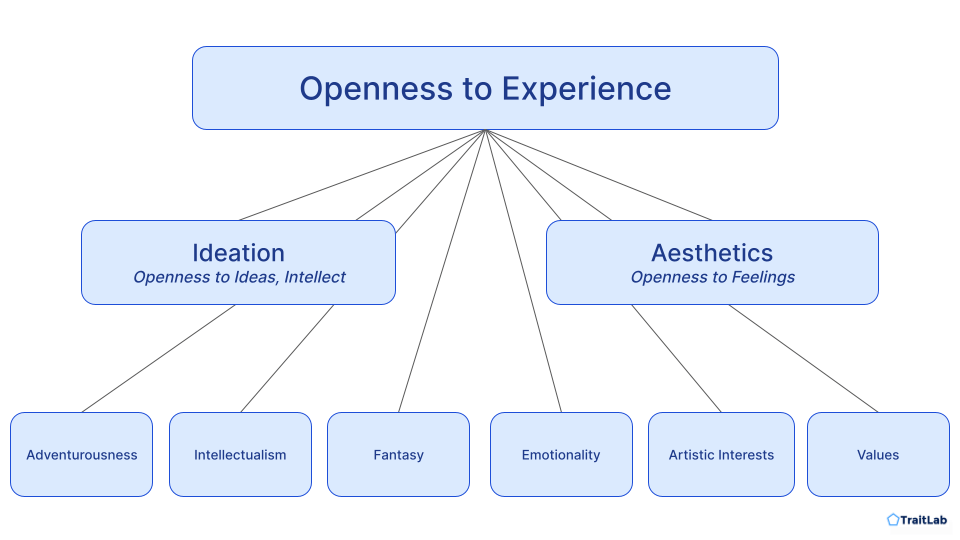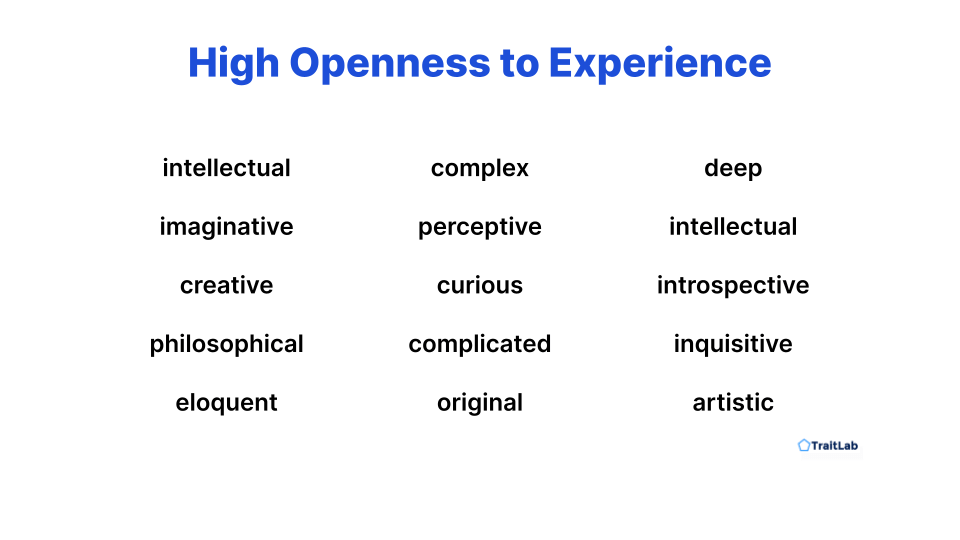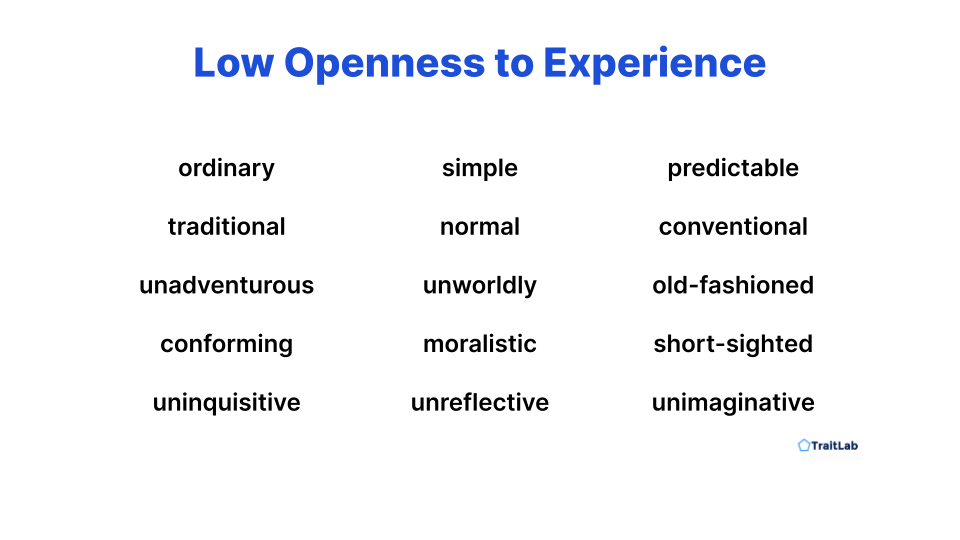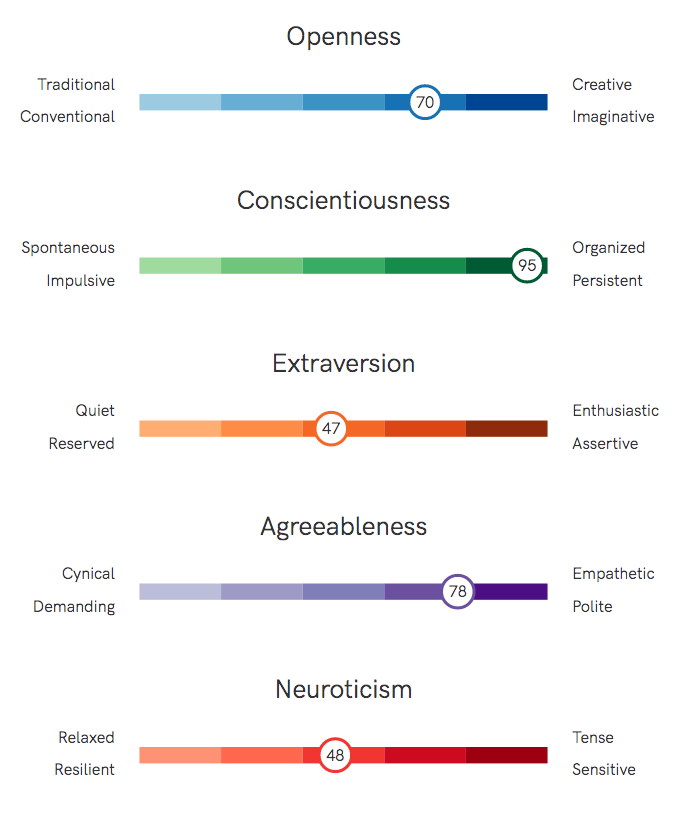Openness to Experience captures differences in curiosity, creativity, tolerace for ambiguity, information processing, and more.
Reading time: 12 minutes

Gregory Park, Ph.D.
Author
Openness to Experience is a broad dimension of personality that captures traits related to curiosity, imagination, artistic interests, preference for novelty, and tolerance for ambiguity. Openness to Experience, or simply Openness, is one of the five domains in the Big Five taxonomy of personality traits.
People who score higher on Openness tend to be curious, seek out novel experiences and ideas, and have diverse interests, particularly in philosophical and artistic areas. Highly open people are also more likely to tolerate or embrace unconventional beliefs and values.
Conversely, those who score lower on Openness are usually more conventional, prefer familiarity, and often have a narrower set of interests. Less open people are more likely to embrace orthodox beliefs and defend traditional ways of doing things.
While Openness is often measured and described as a single, global dimension of personality, it encompasses several narrower, highly correlated traits.

Openness captures two subdomains or aspects: Aesthetics and Ideation. Aesthetics (also called Openness to Feelings or Openness to Aesthetics ) includes traits related to fantasy and artistic interests. Ideation (also called Intellect or Openness to Ideas) captures traits related to intellectual curiosity and philosophical interests.
Openness can be decomposed further into six narrower, more specific subdomains called facets. Facets of Openness and their alternate names include:
Openness to Experience can be measured through self-descriptions, descriptions from informants (e.g., friends, partners, or relatives), behavioral cues, or linguistic cues.
Self-descriptions may take the form of agreement with specific adjectives or with statements about oneself. Highly open people describe themselves with words such as intellectual, deep, complex, imaginative, and introspective.

In contrast, less open people are more likely to use words such as simple, predictable, conventional, traditional, and old-fashioned. Informants (e.g., friends and relatives) use similar adjectives to describe more or less open people.1

Highly open people also agree with statements such as “I spend time reflecting on things,” “I am interested in abstract ideas,” and “I enjoy challenging reading material.” Less open people tend to disagree with those statements and endorse statements such as “I seldom daydream,” “I believe that there is an absolute right and wrong,” and “I dislike change.”
With sufficient language samples, Openness can be measured through a person’s word choice and other linguistic cues.2 The language of highly open people is generally more complex – it contains more articles (a, an, the), prepositions (in, about, around), and conjunctions (and, but, rather).
Highly open people also use more words related to insight (explain, clarify, idea), perceptual (look, smell, feel), and cognitive (rethink, determine, evaluate) processes. In social media posts, highly open people are also more likely to write about abstract topics related to art, music, philosophy, literature, and recently learned ideas, while less open people are more likely to write about concrete activities, plans for the day, and positive well-wishing to others.3

How open are you?
Try a brief Big Five personality measure and see your relative Openness to Experience.
A meta-analysis of dozens of studies on creativity and personality revealed that higher Openness to Experience is associated with creative achievement in scientific and artistic domains. Across all Big Five dimensions, the most significant personality differences between artists and non-artists – as well as between highly creative scientists and less creative scientists – was their level of Openness to Experience.4
Recent research at the aspect level suggests that subcomponents of Openness predict different types of creativity. For example, the aspects of Openness – Aesthetics and Ideation – differentially predict specific types of creative achievement. People higher on the Aesthetics aspect were more likely to have creative achievements in visual arts, music, dance, theater, and film, while Ideation was a stronger predictor of achievement in scientific discovery and invention.5
Several creativity researchers have focused on the role of divergent thinking in the creative process. In contrast to convergent thinking, which narrowly focuses on a single, correct answer, divergent thinking widens one’s focus, finds new associations, and generates multiple potential solutions.
A popular method of measuring divergent thinking ability is to ask participants to generate as many answers as possible to prompts such as,
Of all the Big Five dimensions, Openness has the most robust and consistent associations with divergent thinking. Scores on Openness at all levels – the global dimension, aspects, and facets – are predictive of higher scores on a variety of divergent thinking tasks.5,6,7
Openness also predicts creative performance under time pressure. In general, most people perform worse on creative tasks as time pressure increases, even in highly supportive environments. However, this trend does not hold among highly open people. Instead, highly open people often perform best under moderate time pressure but worse at either extreme (very low or very high time pressure).8
While Openness to Experience is usually described in relation to higher-level, abstract concepts (e.g., art, literature, philosophy, and aesthetics), research has also linked Openness to differences in lower-level visual processing.
While the visual system receives an enormous amount of incoming stimuli, only a tiny portion of stimuli reaches conscious awareness. A dramatic example of this process occurs in binocular rivalry, a visual processing phenomenon in which the stimuli to each eye battle for attention.9
In laboratory studies of binocular rivalry, research participants are shown two different images simultaneously: one in the left eye and one in the right eye. Although both images are clearly presented, participants typically only consciously see one of the two at a time, as visual attention alternates between the left and the right images.
However, many participants experience a momentary merging of the two images, an experience known as a mixed percept. During the mixed percept event, both images appear blended into a single image. However, this event is short-lived, and awareness soon alternates between the left and right images again.
Researchers at the University of Melbourne found that openness to Experience predicts a person’s susceptibility to the mixed percept, such that more open people experience the mixed percept more frequently and for longer durations.10 This greater susceptibility suggests the underlying mechanisms behind Openness extend to lower level sensory processing. Just as highly open people are more likely to make novel conceptual associations, they are similarly more likely to combine more basic sensory information.
Because attention is a limited resource, people often have a narrow visual focus, ignoring most objects and other information in their immediate environment. Occasionally, this leads people to overlook important and otherwise prominent features, a phenomenon known as inattentional blindness. In laboratory studies, participants who are engaged in a simple visual task (e.g., counting the number of people wearing white shirts) often miss highly unusual and prominent objects in the same visual space.10 In a classic demonstration of inattentional blindness, participants watching a short video failed to notice a large gorilla walking through the center of the frame due to their focus on a counting task.11,12
Researchers from the University of Bonn and German Sport University Cologne found that susceptibility to inattentional blindness correlates negatively with Openness, such that highly open people are less likely to miss the objects outside their immediate attention.14 The authors of the study theorized that “conscious perception of individuals scoring high on openness thus seems to be less restricted to expected and task-relevant stimuli, such that unexpected objects can pass the threshold of consciousness more readily” (p. 10).
When participants are exposed to stimuli without consequence or other indication of significance, they implicitly learn to ignore these stimuli in future tasks, a process known as latent inhibition.15 On one hand, latent inhibition is arguably adaptive, because this process conserves attentional resources by ignoring inconsequential stimuli in the environment. But on the other hand, once people implicitly categorize a stimulus as “irrelevant,” they are slower to learn new associations with this stimulus if it becomes relevant later.
Openness to Experience predicts the relative strength of the latent inhibition experienced by an individual in laboratory studies. As Openness increases, the latent inhibition effect is weaker and irrelevant stimuli receive more attention.
Latent inhibition reflects an adaptive attentional ‘gating’ system for screening out irrelevant information, but for open people this system appears to be more flexible, resulting in continued processing of stimuli from which the average individual has disengaged.
Antinori, Carter, & Smillie, 2017, p. 15
In a series of replication studies out of the University of Toronto and Harvard University, researchers found that Openness to Experience impacted performance on tasks related to latent inhibition.16,17
In one task, participants had to learn rules based on audio cues determining when dots appeared on a computer screen. Before that task, some participants were exposed to the same audio cues in a seemingly random, meaningless order. This pre-exposure induced the latent inhibition effect in those participants, such that they were slower to learn the rules in the proceeding task. The degree of the latent inhibition effect, however, was strongly correlated with Openness to Experience.
Higher Openness to Experience also correlates with a heightened awareness and sensitivity to internal states and emotions. Several subcomponents of Openness (e.g., the Aesthetics aspect and the Emotionality and Artistic Interests facets) relate to aesthetic and emotional experiences.
Individuals differ in their propensity to experience mixed emotions, a simultaneous blend of positive and negative affect. For example, in one study, researchers found that more open people were more likely to experience these mixed emotional states 18. However, a related study failed to replicate the correlation between Openness and mixed emotions 19.
People also vary in the complexity of their emotional appraisals of aesthetic experiences. For example, in response to a provocative work of art, some people will have uniformly positive or negative reactions. However, others will experience a more complex blend of both positive and negative feelings. These blended reactions, also known as mixed appraisals, are more common among people scoring highly on Openness to Experience 20.
Aesthetic chills, sometimes experienced as “goosebumps,” are spontaneous, pleasant emotional reactions triggered by an intensely beautiful or profound experience. Personality psychologist Robert McCrae has suggested that aesthetic chills are one of the defining, universal markers of high Openness to Experience 21. McCrae found that highly open individuals were more likely to report the experience of aesthetic chills across 51 cultures.
Before discovering the Openness to Experience dimension, researchers noted that individuals differed reliably in their susceptibility to absorption. Absorption refers to the ease with which one’s awareness becomes fully absorbed by an altered state of consciousness, such as hypnosis, fantasy, or spiritual and mystical experience.22,23 In correlational studies, absorption correlates with several components of Openness to Experience, including facets related to fantasy and imagination.24
One related altered state is awe, or feeling pleasantly humbled, transcendent, and engulfed by a beautiful or profound experience. Some people experience awe more frequently than others, and one predictor of this susceptibility to awe is their relative Openness to Experience. In a study on awe and Openness, researchers exposed participants to two potentially awe-inspiring stimuli: images of space and emotionally moving music (specifically “Hoppípolla” by Sigur Rós). Highly open people were more likely to experience awe from both the space images and the music exposure.25
Several studies have found connections between Openness to Experience and political attitudes.26,27,28 In a meta-analysis of personality and political attitudes, researchers found that higher Openness to Experience correlated consistently with several dimensions of left-wing or liberal (vs. right-wing or conservative) political ideology.29 More open people were more likely to describe their general political views as liberal than conservative.
Additional analyses from the same meta-analysis focused on the relationships between Openness and social and cultural issues (e.g., abortion, separation of church and state, affirmative action) versus economic issues (e.g., taxation, welfare, privatization of social security). Again, more open people were significantly more likely to endorse liberal views on social and cultural issues, but Openness did not significantly predict views on more partisan economic issues.
Similar patterns between Openness and political attitudes exist in regional analyses of personality differences. For example, across U. S. counties, researchers found that the average Openness of a county’s inhabitants predicted the overall county vote in the 2012 and 2016 U.S. presidential elections.30 Specifically, regions with a higher average Openness were significantly more likely to vote for the Democratic candidate, even after adjusting for potential confounding variables such as population density, demographics, and average income. The same pattern appears at different levels of analyses, such as U.S. states or broader multi-state regions.31,32,33
Openness to Experience also predicts patterns of career interests, or preferences for specific types of work or working environments. For example, in a meta-analysis of 24 samples, researchers from Iowa State University found that Openness consistently predicted stronger Artistic and Investigative interests and weaker Conventional interests.34
These findings suggest that highly open people gravitate towards careers that require working with abstract ideas, creativity, design, open-ended research, and unstructured environments. While there is a vast range of careers that fit that description, a few examples of careers with high Artistic, high Investigative, and low Conventional interests include:
Conversely, lower Openness to Experience predicts the opposite pattern of interests: higher Conventional and lower Artistic and Investigative interests. These careers are more likely to have highly structured environments and demand adherence to well-defined rules and procedures. Examples of these careers include:
Like all Big Five dimensions, Openness to Experience captures a broad range of more specific personality traits. In some cases, dimensions from alternative personality models are simply Openness to Experience (or one of its subcomponents) by a different name.
The personality framework suggested by the Myers-Briggs Type Indicator — also known as the MBTI or “16 Personality” types — claims that individuals fall into distinct personality types. These types are defined by their preferences for different cognitive functions.
According to this framework, there are two cognitive functions for perceiving or taking in new information about the world: Sensing and Intuition. People develop a strong preference for one of the two functions, and this preference partly determines their personality type.
Sensing refers to perception through the sensory system. Through sensing perception, people gain awareness of their immediate environment directly with their senses in the present moment.
Intuition refers to perception from sources other than the sensory system. For example, people use intuitive perception to perceive abstract patterns and connections between ideas or notice a “gut feeling” about a situation.
The Myers-Briggs Type Indicator contains measurement scales for both Sensing and Intuition. Scores on these scales determine whether an individual is classified as preferring Sensing (S) or Intuition (N) as their perceiving function.
Several research studies have compared individuals’ scores on the Myers-Briggs Type Indicator and Big Five dimensions.35,36,37,38 One consistent finding is that Openness to Experience captures the bulk of individual differences in Sensing-Intuition. Across four studies, correlations between Openness to Experience and Sensing-Intuition scales range from 0.64 to 0.71 (out of a maximum of 1.0).35
Highly open people are much more likely to be classified by the MBTI as preferring Intuition (N). Conversely, less open people are much more likely to be classified as preferring Sensing (S).
Despite their empirical overlap, there are significant conceptual differences between Openness to Experience and Sensing-Intuition.
First, Openness to Experience describes patterns of thinking, feeling, and behaving on a broad spectrum. People may fall at the lower end, the higher end, and anywhere in between. On the other hand, Sensing-Intuition classifies people into distinct types that prefer one function over the other.
Secondly, Openness to Experience is purely descriptive and makes no claims about underlying cognitive mechanisms, unconscious forces, or personal history. In contrast, Sensing-Intuition and other concepts from the MBTI framework are part of a complex theoretical framework based on the work of psychiatrist Carl Jung.
In a systematic review of research on the Enneagram, a popular personality framework centered on nine personality types, several Enneagram types correlated with Openness to Experience.39
Higher Openness was more common among people classified as Type 4: The Individualist or Type 7: The Enthusiast, while lower Openness often characterized those classified as Type 6: The Loyalist.
1 Goldberg, L. R. (1990). An alternative” description of personality”: the big-five factor structure. Journal of personality and social psychology, 59(6), 1216-1229.
2 Park, G., Schwartz, H. A., Eichstaedt, J. C., Kern, M. L., Kosinski, M., Stillwell, D. J., … & Seligman, M. E. (2015). Automatic personality assessment through social media language. Journal of personality and social psychology, 108(6), 934-952.
3 Schwartz, H. A., Eichstaedt, J. C., Kern, M. L., Dziurzynski, L., Ramones, S. M., Agrawal, M., … & Ungar, L. H. (2013). Personality, gender, and age in the language of social media: The open-vocabulary approach. PloS one, 8(9), e73791.
4 Feist, G. J. (1998). A meta-analysis of personality in scientific and artistic creativity. Personality and social psychology review, 2(4), 290-309.
5 Kaufman, S. B., Quilty, L. C., Grazioplene, R. G., Hirsh, J. B., Gray, J. R., Peterson, J. B., & DeYoung, C. G. (2016). Openness to experience and intellect differentially predict creative achievement in the arts and sciences. Journal of personality, 84(2), 248-258.
6 McCrae, R. R. (1987). Creativity, divergent thinking, and openness to experience. Journal of personality and social psychology, 52(6), 1258-1265.
7 Silvia, P. J., Nusbaum, E. C., & Beaty, R. E. (2017). Old or new? Evaluating the old/new scoring method for divergent thinking tasks. The Journal of Creative Behavior, 51(3), 216-224.
8 Baer, M., & Oldham, G. R. (2006). The curvilinear relation between experienced creative time pressure and creativity: moderating effects of openness to experience and support for creativity. Journal of Applied psychology, 91(4), 963-970.
9 Tong, F., Meng, M., & Blake, R. (2006). Neural bases of binocular rivalry. Trends in cognitive sciences, 10(11), 502-511.
10 Antinori, A., Carter, O. L., & Smillie, L. D. (2017). Seeing it both ways: Openness to experience and binocular rivalry suppression. Journal of Research in Personality, 68, 15-22.
11 Neisser, U., & Becklen, R. (1975). Selective looking: Attending to visually specified events. Cognitive psychology, 7(4), 480-494.
12 Simons, D. J., & Chabris, C. F. (1999). Gorillas in our midst: Sustained inattentional blindness for dynamic events. perception, 28(9), 1059-1074.
13 Drew, T., Võ, M. L. H., & Wolfe, J. M. (2013). The invisible gorilla strikes again: Sustained inattentional blindness in expert observers. Psychological science, 24(9), 1848-1853.
14 Kreitz, C., Schnuerch, R., Gibbons, H., & Memmert, D. (2015). Some see it, some don’t: Exploring the relation between inattentional blindness and personality factors. PloS one, 10(5), e0128158.
15 Lubow, R. E., & Gewirtz, J. C. (1995). Latent inhibition in humans: data, theory, and implications for schizophrenia. Psychological bulletin, 117(1), 87-103.
16 Peterson, J. B., & Carson, S. (2000). Latent inhibition and openness to experience in a high-achieving student population. Personality and individual Differences, 28(2), 323-332.
17 Peterson, J. B., Smith, K. W., & Carson, S. (2002). Openness and extraversion are associated with reduced latent inhibition: Replication and commentary. Personality and Individual Differences, 33(7), 1137-1147.
18 Barford, K. A., & Smillie, L. D. (2016). Openness and other Big Five traits in relation to dispositional mixed emotions. Personality and individual differences, 102, 118-122.
19 Barford, K. A., Koval, P., Kuppens, P., & Smillie, L. D. (2020). When good feelings turn mixed: Affective dynamics and big five trait predictors of mixed emotions in daily life. European Journal of Personality, 34(3), 393-411.
20 Barford, K. A., Fayn, K., Silvia, P. J., & Smillie, L. D. (2018). Individual differences in conflicting stimulus evaluations: Openness/intellect predicts mixed-valenced appraisals of visual art. Journal of Research in Personality, 73, 46-55.
21 McCrae, R. R. (2007). Aesthetic chills as a universal marker of openness to experience. Motivation and Emotion, 31(1), 5-11
22 McCrae, R. R., & Costa Jr, P. T. (1997). Conceptions and correlates of openness to experience. In Handbook of personality psychology (pp. 825-847). Academic Press.
23 Tellegen, A., & Atkinson, G. (1974). Openness to absorbing and self-altering experiences (“ absorption”), a trait related to hypnotic susceptibility. Journal of abnormal psychology, 83(3), 268-277.
24 Glisky, M. L., Tataryn, D. J., Tobias, B. A., Kihlstrom, J. F., & McConkey, K. M. (1991). Absorption, openness to experience, and hypnotizability. Journal of Personality and Social Psychology, 60(2), 263-272.
25 Silvia, P. J., Fayn, K., Nusbaum, E. C., & Beaty, R. E. (2015). Openness to experience and awe in response to nature and music: Personality and profound aesthetic experiences. Psychology of Aesthetics, Creativity, and the Arts, 9(4), 376.
26 Ekehammar, B., Akrami, N., Gylje, M., & Zakrisson, I. (2004). What matters most to prejudice: Big five personality, social dominance orientation, or right‐wing authoritarianism?. European journal of personality, 18(6), 463-482.
27 Gosling, S. D., Rentfrow, P. J., & Swann Jr, W. B. (2003). A very brief measure of the Big-Five personality domains. Journal of Research in personality, 37(6), 504-528.
28 McCrae, R. R. (1996). Social consequences of experiential openness. Psychological bulletin, 120(3), 323-337.
29 Carney, D. R., Jost, J. T., Gosling, S. D., & Potter, J. (2008). The secret lives of liberals and conservatives: Personality profiles, interaction styles, and the things they leave behind. Political psychology, 29(6), 807-840.
30 Ebert, T., Gebauer, J. E., Brenner, T., Bleidorn, W., Gosling, S. D., Potter, J., & Rentfrow, P. J. (2022). Are regional differences in psychological characteristics and their correlates robust? applying spatial-analysis techniques to examine regional variation in personality. Perspectives on Psychological Science, 17(2), 407-441.
31 Rentfrow, P. J., Gosling, S. D., Jokela, M., Stillwell, D. J., Kosinski, M., & Potter, J. (2013). Divided we stand: three psychological regions of the United States and their political, economic, social, and health correlates. Journal of personality and social psychology, 105(6), 996-1012.
32 Rentfrow, P. J., Jost, J. T., Gosling, S. D., & Potter, J. (2009). Statewide differences in personality predict voting patterns in 1996–2004 US presidential elections. Social and psychological bases of ideology and system justification, 1, 314-349.
33 Giorgi, S., Nguyen, K. L., Eichstaedt, J. C., Kern, M. L., Yaden, D. B., Kosinski, M., … & Park, G. (2022). Regional personality assessment through social media language. Journal of personality, 90(3), 405-425.
34 Larson, L. M., Rottinghaus, P. J., & Borgen, F. H. (2002). Meta-analyses of Big Six interests and Big Five personality factors. Journal of Vocational Behavior, 61(2), 217-239.
35 Furnham, A., Moutafi, J., & Crump, J. (2003). The relationship between the revised NEO-personality inventory and the Myers-Briggs type indicator. Social Behavior and Personality: an international journal, 31(6), 577-584.
36 Furnham, A. (1996). The big five versus the big four: the relationship between the Myers-Briggs Type Indicator (MBTI) and NEO-PI five factor model of personality. Personality and individual differences, 21(2), 303-307.
37 MacDonald, D. A., Anderson, P. E., Tsagarakis, C. I., & Holland, C. J. (1994). Examination of the relationship between the Myers-Briggs Type Indicator and the NEO Personality Inventory. Psychological Reports, 74(1), 339-344.
38 McCrae, R. R., & Costa Jr, P. T. (1989). Reinterpreting the Myers‐Briggs type indicator from the perspective of the five‐factor model of personality. Journal of personality, 57(1), 17-40.
39 Hook, J. N., Hall, T. W., Davis, D. E., Van Tongeren, D. R., & Conner, M. (2021). The Enneagram: A systematic review of the literature and directions for future research. Journal of Clinical Psychology, 77(4), 865-883.